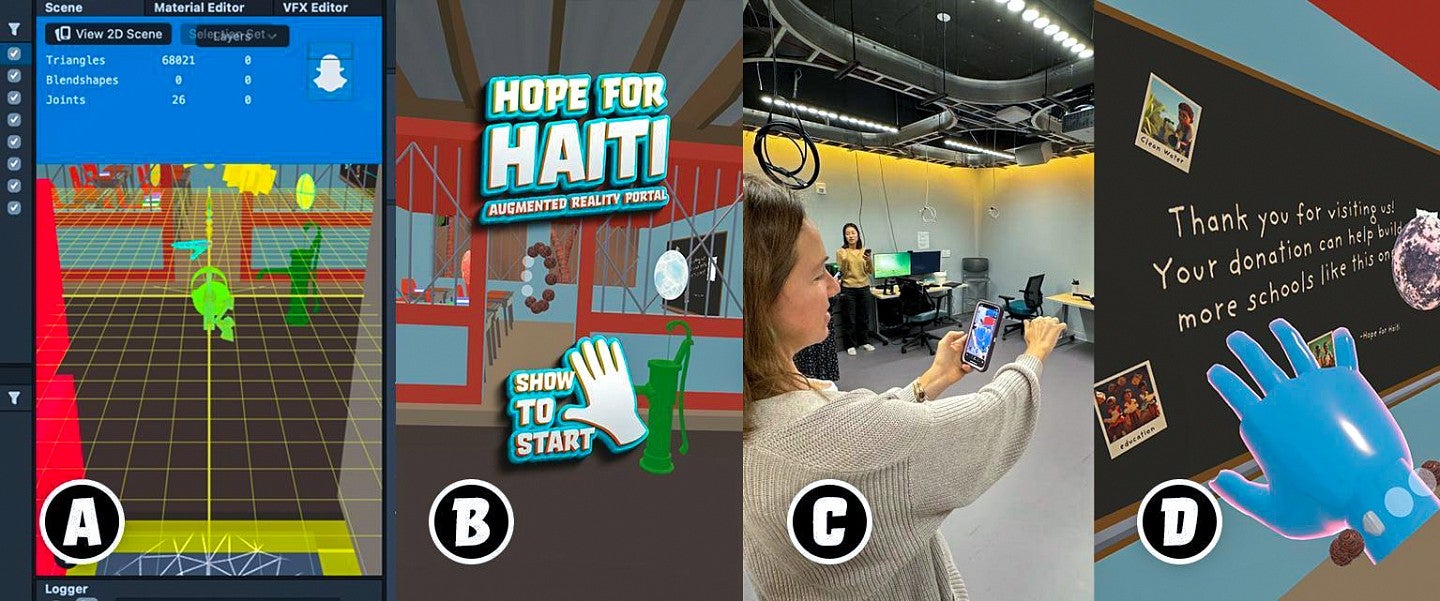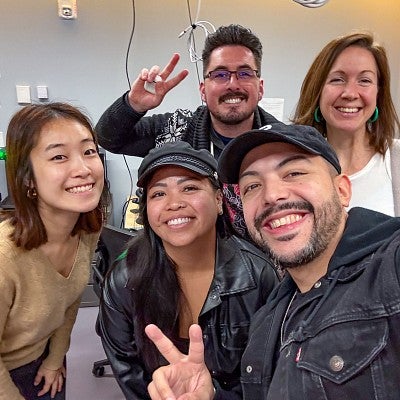Faculty leader and SOJC Assistant Professor of Immersive Media Psychology Danny Pimentel describes the Snap AR Scholars student-led agency, which teaches students how to build AR content and research the effectiveness of their Snapchat lens for the nonprofit Hope for Haiti. Video courtesy of Danny Pimentel.
“How far away is Haiti?”
That’s what Danny Pimentel, faculty director of the Snap AR Scholars program, and his team of researchers asked undergraduate student participants to gauge their familiarity with the island nation roughly 3,400 miles from Portland.
Their response: several thousand miles.
The participants were then asked to open Snapchat to try out an augmented reality (AR) lens called Hope for Haiti AR, created with Snapchat’s no-code software, Lens Studio. Using the cameras on their phones, participants entered a virtual schoolhouse in Haiti where they were presented with a beaded bracelet. For every step they took, every item they interacted with and every new piece of information they learned as they walked through the school, a new bead was added to their bracelet.
It was all part of an immersive media pilot project undertaken by the Snap AR Scholars program, a newly formed cohort of graduate students who, in collaboration with the UO School of Journalism and Communication’s (SOJC) Oregon Reality Lab (OR Lab), create interactive stories that promote the work of nonprofits. Industry partner Snapchat provided the team with resources and technical support.

Using immersive media for social impact
Snap AR Scholars was created when Pimentel, an SOJC assistant professor of immersive media psychology in the SOJC’s new Immersive Media Communication Master’s program, pitched the idea of a student-led creative AR agency to Stacey Long-Genovese, Ph.D., the global head of education, learning and training at Snap Inc. Pimentel said he wanted to teach non-STEM students who have no coding experience how to use AR content for social impact.
This year’s organization was Hope for Haiti, which supports economic, social and humanitarian relief in Haiti. The project’s goal is to drive donations to the organization by creating a compelling story to help viewers connect emotionally with the people of Haiti.
Getting donations for organizations that don’t seem relevant to Americans or that are far away from the United States is difficult, said Pimentel, who co-directs the OR Lab at SOJC Portland. “So the question becomes, how do we tell stories that reduce those gaps so you donate?” he said. “Because if you reduce those gaps, if you make things appear closer to you, more personally relevant, you care more about it. You’re more likely to take action.”
After the student volunteers engaged with the Hope for Haiti AR experience, their perceived distance from Haiti was shorter — a direct result of learning about the community, said Sam Lorenzo, a third-year Ph.D. candidate in the SOJC’s Communication and Media Studies program.
Lorenzo worked as a designer and researcher for the Snap AR Scholars program and will present the research and its impact at the Meaningful XR Conference in May. The presentation will cover the team’s work over the past eight months, which included consulting with Hope for Haiti, designing the AR experience, testing it and quantifying its results.
Getting started with immersive media storytelling
The project kicked off in September, once all 11 students were selected and Hope for Haiti was chosen as the nonprofit they’d be working with. The first step for the design team was creating a compelling AR story to pitch to Hope for Haiti.
The team of five students met once a week during winter term to discuss and tweak the design and answer the research team’s questions about its effectiveness — questions like, Are we sending the right message? How are we telling the story? Is it functioning?
Kathleen Darby, a student in the Immersive Media Communication Master’s program, was in Pimentel’s class when she joined the team as a lead user experience designer.

Darby said she was initially intimidated by the project’s parameters. Her limited knowledge of coding and Lens Studio, she thought, would put her at a disadvantage. But she soon realized her skills made her right at home.
Her experience using Adobe software allowed her to specialize in 2D storyboarding. When her proposal was approved, she worked with Luke Walker to develop it in Lens Studio.
Walker, a Strategic Communication and Immersive Media Communication dual master's student, had used similar software before and worked with other designers with different skill sets to develop the lens.
As the lead developer of the lens, Walker spearheaded the design efforts and used his experience to help his teammates become comfortable with the software.
Creating AR storytelling requires various skill sets
For Darby, Walker and the rest of the designers, collaboration and peer assistance make the team successful. The program was new to all the students, and it took them a while to understand general aspects of the software like how elements were connected or triggered in the program, Darby said. Sometimes they’d spend hours troubleshooting the software.
Meanwhile, the designers were getting feedback from the research team and creating the final project proposals and program.
“The research and design team are very supportive of each other. Everybody has great ideas and no one’s shy about sharing their thoughts,” Lorenzo said. “It makes for a good cohesive team.”
After months of designing, tweaking, troubleshooting, editing and more designing, the lens was finalized in January, and the team was able to see the tangibility of the work they’d done.
“I really enjoyed the process of strategizing a thing that would be created with augmented reality,” Darby said. “It was really exciting to me that we're actually making something right away and learning to use these tools.”
For Pimentel, this is one of the values of the program. “It's not just a class project that dies off, that gives you a grade. This is actually going to be used by the organization in their campaigns and hopefully create a positive impact,” he said.

Measuring the effectiveness of immersive media
In the spring, the research team took over to quantify whether the designers had succeeded in making that impact.
The team designed and ran experiments in the Immersive Media Lab in Allen Hall, where undergraduate students tried out the program and answered questions before and after the experience. The research team then worked together to interpret the results and write a research paper and case study, which will make up their presentation in May.
Shane Burrell, a third-year Ph.D. candidate in the SOJC’s Communication and Media Studies doctoral program and lead researcher for the program, said the project not only allowed him to further his career in research but also taught him to stay organized, work with a team and establish open communication.
And it gave him a place to collaborate with like-minded students. “We’re all Ph.D. students (on the research team). But as we talk, we all are just students as well. We can laugh and then share complicated ideas and concepts,” Burrell said.

Gaining experience in social-impact research
The research team met weekly throughout the year to advise the design team and create experiments that would best show the effect of the program. They also created flyers, scheduled lectures and set up the student volunteering.
For Lorenzo, working on the research team meant getting real-world experience for a career in social impact research. “I knew what direction I wanted to go in, but by being involved in Snap AR Scholars,” she said, “my own research guided me to (think), ‘OK, this is my next step.’”
Once the team finishes a second study, analyzes the data and makes final changes to the experience, they’ll work with Hope for Haiti to make it go live and become an immersive media resource their communication team can use strategically, said Pimentel.
“At that point, any user with a phone and Snapchat will be able to try it," Pimentel said.
While the project helped team members gain hands-on experience, hone software skills and build their portfolios, they agreed the best part was being surrounded by diverse individuals who each brought something to the table.
“You’re working with a dynamic team of people who come from different perspectives … in terms of their skill sets, in terms of their cultural backgrounds, in terms of what field they’re in,” Pimentel said.
The program offers opportunities for every major, every year and every student, Pimentel said. Whether a student wants to do design or research, advertising or coding, social work or AR creation, “there's a fit for everyone everywhere in our club,” said Burrell.
If you are interested in joining the Snap AR Scholars program next year, complete the online form or email Pimentel at pimend@uoregon.edu.
—By Julia Boboc, class of ’26
Julia Boboc is a second-year journalism major in the UO School of Journalism and Communication direct-admit program and a member of Clark Honors College. She especially enjoys interviewing and writing about people and feels everyone has a story to tell. She loves trying new things in journalism and taking on cool projects. She also produces a podcast, “How It’s Reported,” for the Daily Emerald.
